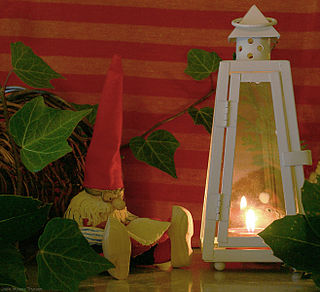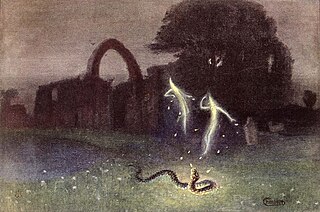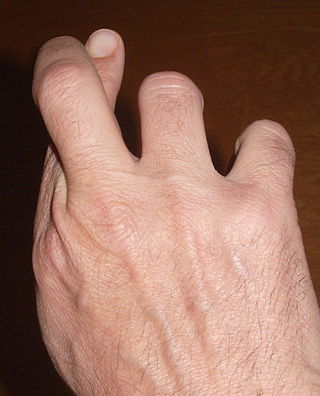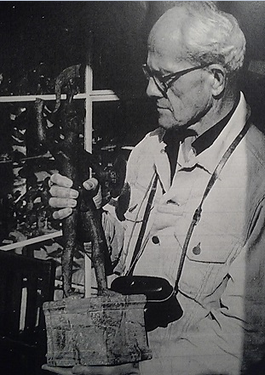Related Research Articles
The draugr or draug is an undead creature from the Scandinavian saga literature and folktales.

Sir Lawrence Alma-Tadema,, RWS was a Dutch painter who later settled in the United Kingdom, becoming the last officially recognised denizen in 1873. Born in Dronryp, the Netherlands, and trained at the Royal Academy of Antwerp, Belgium, he settled in London, England in 1870 and spent the rest of his life there.

A nisse, tomte, tomtenisse, or tonttu is a mythological creature from Nordic folklore today typically associated with the winter solstice and the Christmas season. They are generally described as being short, having a long white beard, and wearing a conical or knit cap in gray, red or some other bright colour. They often have an appearance somewhat similar to that of a garden gnome.

In folklore, a will-o'-the-wisp, will-o'-wisp, or ignis fatuus, is an atmospheric ghost light seen by travellers at night, especially over bogs, swamps or marshes. The phenomenon is known in much of European folklore by a variety of names, including jack-o'-lantern, friar's lantern, and hinkypunk, and is said to mislead travellers by resembling a flickering lamp or lantern. In literature, will-o'-the-wisp metaphorically refers to a hope or goal that leads one on, but is impossible to reach, or something one finds strange or sinister. Wills-o'-the-wisp appear in folk tales and traditional legends of numerous countries and cultures; notable named examples include St. Louis Light in Saskatchewan, the Spooklight in Southwestern Missouri and Northeastern Oklahoma, the Marfa lights of Texas, the Naga fireballs on the Mekong in Thailand, the Paulding Light in Upper Peninsula of Michigan, and the Hessdalen light in Norway.

A jack-o'-lantern is a carved lantern, most commonly made from a pumpkin or a root vegetable such as a rutabaga or turnip. Jack-o'-lanterns are associated with the Halloween holiday. Its name comes from the reported phenomenon of strange lights flickering over peat bogs, called will-o'-the-wisps or jack-o'-lanterns. The name is also tied to the Irish legend of Stingy Jack, a drunkard who bargains with Satan and is doomed to roam the Earth with only a hollowed turnip to light his way.

The Weald is an area of South East England between the parallel chalk escarpments of the North and the South Downs. It crosses the counties of Hampshire, Surrey, West Sussex, East Sussex, and Kent. It has three separate parts: the sandstone "High Weald" in the centre; the clay "Low Weald" periphery; and the Greensand Ridge, which stretches around the north and west of the Weald and includes its highest points. The Weald once was covered with forest, and its name, Old English in origin, signifies "woodland". The term is still used today, as scattered farms and villages sometimes refer to the Weald in their names.

A pixie is a mythical creature of British folklore. Pixies are speculated to be particularly concentrated in the high moorland areas around Devon and Cornwall, suggesting some Celtic origin for the belief and name.

A spriggan is a legendary creature from Cornish folklore. Spriggans are particularly associated with West Penwith in Cornwall.

English in Southern England is the collective set of different dialects and accents of Modern English spoken in Southern England.

Æthelwealh was ruler of the ancient South Saxon kingdom from before 674 till his death between 680 and 685. He was baptised in Mercia, becoming the first Christian king of Sussex. He was killed by a West Saxon prince, Cædwalla, who eventually became king of Wessex.

Cumbrian dialect or Cumberland dialect is a local dialect of Northern England in decline, spoken in Cumberland, Westmorland and Lancashire North of the Sands. Sounding similar and not to be confused with the area's extinct Celtic language, Cumbric. Some parts of Cumbria have a more North-East English sound to them. Whilst clearly spoken with a Northern English accent, the Cumbrian dialect shares much vocabulary with Scots. A Cumbrian Dictionary of Dialect, Tradition and Folklore by William Rollinson exists, as well as a more contemporary and lighthearted Cumbrian Dictionary and Phrase Book.

The Bedfordshire clanger is a dish from Bedfordshire and adjacent counties in England, such as Buckinghamshire and Hertfordshire. It dates back to at least the 19th century. It is still available at various bakers and served at some cafes, restaurants and local places of interest.
Nesh is an English dialect adjective meaning 'unusually susceptible to cold weather' and there is no synonym for this use. The Oxford English Dictionary defines the word as: "Soft in texture or consistency; yielding easily to pressure or force. In later use chiefly: tender, succulent, juicy."

A truce term is a word or short phrase accepted within a community of children as an effective way of calling for a temporary respite or truce during a game or activity, such as tag or its variants. Common examples in English speaking cultures are barley, fainites, crosses, kings and exe(s) in the United Kingdom, pegs and nibs in New Zealand and variants of barley in Australia. In the United States, terms based on time-out have, from the 1950s onwards, largely supplanted earlier common terms based on kings and exe(s). Since the late 1980s time-out has been recorded in other English-speaking cultures besides the US. Examples of use of truce terms are if a child has a stitch or wants to raise a point on the rules of the game.

A brownie or broonie (Scots), also known as a brùnaidh or gruagach, is a household spirit or Hobgoblin from Scottish folklore that is said to come out at night while the owners of the house are asleep and perform various chores and farming tasks. The human owners of the house must leave a bowl of milk or cream or some other offering for the brownie, usually by the hearth. Brownies are described as easily offended and will leave their homes forever if they feel they have been insulted or in any way taken advantage of. Brownies are characteristically mischievous and are often said to punish or pull pranks on lazy servants. If angered, they are sometimes said to turn malicious, like boggarts.

"We wunt be druv" is the unofficial county motto of Sussex in southern England. It is a Sussex dialect phrase meaning "we will not be driven". The motto asserts that people from the English county of Sussex have minds of their own, and cannot be forced against their will or told what to do. It is used as a motto of the people of Sussex and the Sussex Bonfire Societies. Since 2016 it has been used as a strapline, part of the re-branding of Harvey's Brewery of Lewes.

John Richard de Capel Wise was a writer and natural historian. Although he wrote on Shakespeare and other subjects, his most successful work was his 1862 book The New Forest: its History and its Scenery, which describes the scenery, the natural history, the antiquities, and the dialect of the New Forest, in Hampshire, England.
A colt pixie is a creature from English folklore in the South and South West of England. According to local mythology, it is a type of Pixie which takes the form of a scruffy, pale horse or pony to lead travellers and other livestock astray, and is often associated with Puck. The earliest surviving written reference dates to the early 16th century.

Leslie Valentine Grinsell was an English archaeologist and museum curator. Publishing over twenty books on archaeology during his lifetime, he was renowned as a specialist on the prehistoric barrows of southern England.
Charles Swainson (1840–1913) M.A. was an English cleric and naturalist. He was rector of High Hurst Wood, Sussex, from 1872 to 1874, from where he published his Handbook of Weather Folk-Lore which also included folklore and mythology relating to elements of nature and a short chapter on birds.
References
- ↑ Wise, John Richard de Capel (1862). "The Folk-Lore and Provincialisms". The New Forest: its history and its scenery. p. 174. Retrieved 9 July 2023.
- ↑ Cooper, Durrant. Sussex Vocabulary, 1854
- ↑ Summers, Montague. The Works of Ophra Benn, Vol 1. p.363 - vide Wright, English Dialect Dictionary
- ↑ The Pleasant history of lazy Laurence, Pen State University Library
- ↑ Pasmore, Anthony. "Richardson Circles – the work of the Forest’s first field archaeologist", Hampshire Field Club & Archaeology Society, Newsletter 43 - Spring 2005